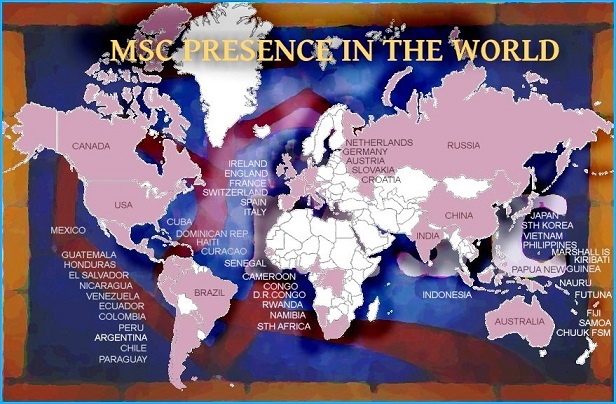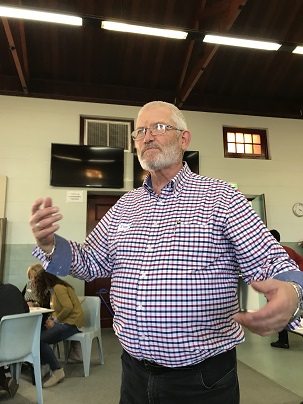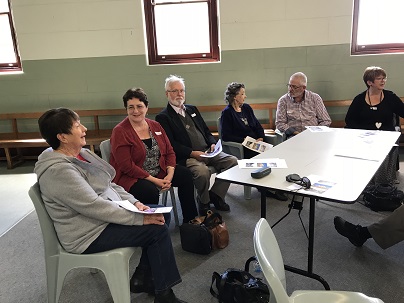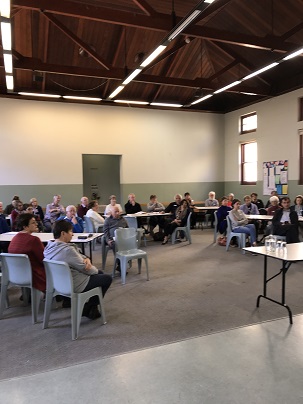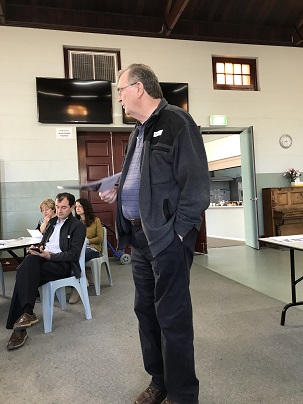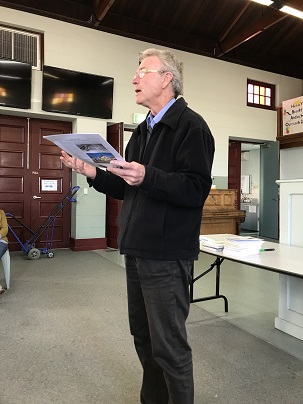WEEKEND REFLECTION - LAY MSC - HENLEY BEACH MEETING

Thanks to Noel Mansfield for text and photos
Father Chevalier always wanted lay-people closely involved with his mission. I’ve always considered everyone in the parish as belonging to our charism and spirituality, so have been a bit ambivalent about starting an MSC Associates group within the parish. However, around 25 years we began a group at Henley Beach, and this eventually became 2 groups, covering people from both parishes and outside. The main aim of the groups was to study the life and spirituality of our Founder and deepen their own living of ‘spirituality of the heart’.
Recently, we became aware that we wanted more than just discussion groups or review of life – we needed to have some real impact on our parish. We have begun to host certain activities, such as days associated with the Feast of the Sacred Heart and the ‘feast’ of Jules Chevalier on October 21. We see ourselves more as of service to the parish and guardians of ‘spirituality of the heart’. We welcome new members, especially anyone interested in growing in our spirituality in their own lives and in the parish.
John Rate
The Charism of Jules Chevalie
Noel Mansfield, MSC
On Sunday, 22 October, there was a meeting of our parishioners who are interested in knowing more about the Charism of Jules Chevalier. There were more than 40 people who gathered at the Henley Beach hall.
Over the past few months, the parishes of Henley Beach and Hindmarsh-Findon have been advertising this event. Over the past couple of weeks, various Lay MSC have spoken at Weekend masses. The hope has been to awaken in the hearts of people a greater awareness of this charism.
John Wallace was the coordinator of the event on Sunday. He introduced each of the speakers. Between each of the talks, he encouraged us all to share what we had heard.
Rev. Robin Trebilcock, a Uniting Church minister, was the first speaker. Robin has been involved with the Lay MSC for many years and has visited Issoudun on a number of occasions. He also attended an MSC Provincial Chapter in Toowoomba. So he has a deep understanding of this charism.
Robin Trebilcock:
LAY MSC SPIRITUALITY - A Mission Focussed Spirituality - Notes
I want to suggest to you that Jules Chevalier’s Spirituality of the Sacred Heart is closely connected to his missionary focus and offer insight into the spirituality through an examination of his earliest mission - to the men of Issoudun. But first, let me open with a look at a discussion topic that you will be considering later:
“People are now more disengaged from, disinterested in, or hostile towards ‘church’.”
Bring to mind someone you know well who fits this description.
Name them (to yourself).
How many of their friends and work colleagues share these attitudes? A few? Some? Most?
How does he/she respond when you talk about your faith?
Would you risk your valued relationship by such a discussion or more likely to play it safe?
This is something I’ve wrestled with all my adult Christian life. It led me to the MSC’s and Heart Spirituality nearly 25 years ago and deeper into Jules Chevalier’s ministry ever since. He, like us, had to deal with a disengaged, disinterested and hostile public. The French Revolution unleashed a wave of popular, rationalist, humanist, anti-church attitudes that he called the mal moderne. These attitudes have grown and extended to become commonplace in the Western world today. His spirituality and missionary endeavour were both a response and an effective counter to them. His early ministry to men is a classic example. We know the results, which were outstanding, but not much else. My quote comes from Hans Kwakman, MSC. He wrote:
“Together with his confrères Maugenest and Piperon, Father Chevalier began to visit all the families in Issoudun to encourage the men to attend a special Mass only for them. After several weeks of home visits, which were often met with refusal, more or less polite, they've finally could count thirty meeting to attend a Mass for men only. These men persevered and their members even increased. During Lent of the year 1857, several hundred men gathered in the barn converted into a chapel to listen to conferences in preparation for Easter, and on Easter Sunday, fifty men received Holy Communion.”
How did he manage that? The terse report of the time glosses over the detail. Only by examining more recent programs and texts have I been able to piece together a probable scenario. The original plan, to focus on the men and to visit their homes and to have a special mass for them, became modified by the love and compassion that the men’s situation evoked in the visitors. The “Mass for Men” was still the end point, but a lot of listening, caring, healing and personal and social transformation happened on the way. So much so that the work’s reputation spread and people across France began making a pilgrimage to Issoudun to find similar wellness for themselves. The inscribed wall tiles in the Basilica are testimony to this.
The social history of the time, of revolution, terror, and the two Napoleonic war defeats, suggests that the distress among the men was akin to the post-traumatic stress that we recognised in returning Vietnam vets. The treatment evolved for the Vietnam veterans (and subsequently used for survivors of similar experiences), is like the attentiveness, compassion, peer support and practical assistance of the spirituality of the Sacred Heart that Jules Chevalier applied, with much success, to the men of Issoudun and subsequently to the pilgrims.
I believe that Chevalier’s visits and conversations also showed him that expecting the men to come to their special Mass at the church was too great a hurdle for them to overcome, so he acquired a barn and made it into a chapel. A barn is a familiar and non-threatening space for men in an agricultural town like Issoudun.
The inclusive, universal appeal of the MSC mission statement, ‘May the Sacred Heart of Jesus be everywhere loved’ was another help to the ministry. In a time of competing ideologies and factions, being loved and included by Jules Chevalier’s ministry no matter who you were or where you stood was in stark contrast to the mortal danger of such differences in the world at large. The image of Our Lady of the Sacred Heart that Jules Chevalier devised in Issoudun would have aided this ministry. Its portrayal, controversial at the time, of a mature Mary offering support, comfort and guidance to 12 year-old Jesus would have evoked memories of times on the battlefield or the barricades when, like 12 year-olds, the image of a comforting, guiding mother’s love supported them through their ordeal. It also made the connection - the heart of God, the heart of Jesus, the heart of their ministry, the Sacred Heart - more explicit.
Has Jules Chevalier’s example with the men of Issoudun any relevance today as a guide for us? Has it enduring worth beyond its time? My answer is, “Yes!” It was an effective response to a hostile environment. It healed and reconciled wounded lives and relationships. It would be just as effective responding to the anti-religious, anti-church attitudes and the social and personal distress of our time.
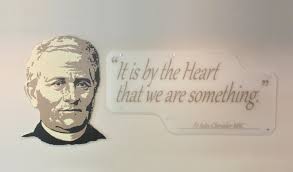
These are the aspects I believe should be reapplied for our time:
- Jules Chevalier’s Lay MSC activity happened in the mission field - the local community - not the church. The three priests visited all the families and grew the ministry by developing trust and a caring relationship with a few, who responded positively to the love and care that was offered, and to the Sacred Heart. They, in turn, had networks of love and care in the neighbourhood through which their new-found experiences could be shared. The group, the conversations, the healing and reconciliation and the relationship with the Sacred Heart grew. Their ‘cold-calling’ approach wouldn’t work today. Sacred Heart spirituality is and was developed and demonstrated in relationships built on conversation, healing and help formed in response to discerned individual and community distress. We need different ways now to initiate it.
- The men gathered in the barn, not the parish church. A barn was a familiar space for men in an agricultural town like Issoudun. We need to consider what are ‘familiar” and non-threatening spaces’ for our time.
- The image of Our Lady of the Sacred Heart helped put people in touch with experiences of love and hope that they knew and understood. And that provided a ground for accepting the ministry of the Sacred Heart that they were being offered. This image has probably lost much of its original potency. What might we use in a similar way?
- Applying the MSC mission statement, ‘May the Sacred Heart of Jesus be everywhere loved’ can take Lay MSC ministry into unexpected places and communities. Honouring its openness and acceptance requires a clear distinction between administering the Sacred Heart and recruiting people to church involvement. Church involvement may be a consequence of the love, trust, help and integrity of the Sacred Heart ministry, but it comes as a gift of the Sacred Heart to the church, not as a manipulation of the relationships involved.
- The special Mass for men was an important element in Chevalier’s approach to people disengaged from, disinterested in, or hostile towards ‘church’. Rationalists/humanists want to be able to explain everything, but, at its most profound level of experience, love cannot be explained - only experienced. Love is a mystery. Experiencing the eucharist is to experience the love of God and the Sacred Heart of Jesus as mystery. Nevertheless, the Mass needed to be ‘special’ - to come out of the experience of love they were receiving from the ministry team of priests and lay people.
Jules Chevalier’s Sacred Heart spirituality is a strong foundation for a Lay MSC ministry today. His pioneering work revealed a new way of being church, one that moved the emphases from head to heart, from exclusive to inclusive, from a distant, judgemental God to a loving, in our midst God who, in the Sacred Heart of Jesus, comes with healing and help in our distress. Lay MSCs are well placed to build from Chevalier’s foundation (with insights from more recent texts and ministries) to become a relevant and potent force for good and for God in our time.
----------
LAY MSC SPIRITUALITY - A Mission Focussed Spirituality - Questions
- People are now more disengaged from, disinterested in, or hostile towards “church”.
Bring to mind someone you know well who fits this description.
Name them (to yourself).
How many of their friends and work colleagues share these attitudes? A few? Some? Most?
How does he/she respond when you talk about your faith?
Would you risk your valued relationship by such a discussion or more likely to play it safe?
What does this say about how the church communicates what it stands for with the public?
What might work?
- Distress
Continue to consider the person you recalled in the first question.
What personal or social issues are causing them distress?
As you share in your group, do some issues loom larger?
- The love of God/the Sacred Heart of Jesus > our love.
Choose one distressing issue (or two).
How might the presence of love and compassion in the situation reduce the distress?
Do we have a role in making this presence felt? How?
How does heart spirituality bring the presence of the love and compassion of God and Jesus to bear on our personal experiences of distress?
-------------
Charism
After a short time for discussion, Paul Cashen gave us an insight into Richelieu, the town where Jules was born and then a picture of Issoudun - the small rural town where he developed his spirituality of the Heart and founded the Missionaries of the Sacred Heart.
Jules Chevalier
Born 15th March 1824 -- Died 21 October 1907
Jules Chevalier was born in the town of Richelieu in central France. The town of Richelieu takes its name from its founder, Cardinal Richelieu the hugely egotistical character who in his time, after the king, (Louis XIII) was the most powerful person in France.
The town is surrounded by walls and moats and people enter through the main gate that divides the town and leads up to what was the Chateau. The Cardinal decided his position demanded a great residence and in 1625 he commissioned the famous architect Jacques Lemercier to design his palace and then the town bearing his name. It was burnt to the ground during the French Revolution as a response by the people to the infamy of the Cardinal.
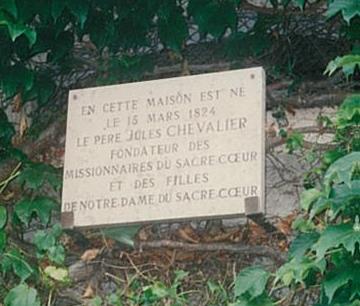
The main church "Eglise Notre Dame" remains in much the same condition as when it was first built, much like the timber framed market hall which is still used for the weekly market. This is where Jules was baptised on the 16th March 1824: there are various works of art that commemorate his life an d work. The church opens onto the Market Square and after walking through the market on the Rue des Halles the first street on the right, 1 Rue du Cygne is where Jules was born. His father was an educated man, but not very successful in either trade or business, and not a religious man at all. Jules' mother could neither read nor write, had never been to school, but was deeply religious. In this ambiguous atmosphere Jules grew up with competence in reading and writing from his father, and an awareness of God in his life from his mother. When he first let it be known that he wanted to be a priest, he was told immediately that this was quite impossible given the family's poor circumstances. He was needed to help support the family and was apprenticed to a shoemaker.
When Jules was seventeen years old, his father was given a job as "caretaker of forests" by a wealthy landowner near Vatan. Hearing that Jules was interested in becoming a priest, this man undertook to pay Jules' fees at the seminary. It was during his seminary days, that Jules Chevalier first dreamed of a group of people dedicated to the Heart of Jesus who would bring a message of love and hope to a world in which there was a complete indifference to God and an antagonism to any form of religion and a general feeling of hopelessness and despair.
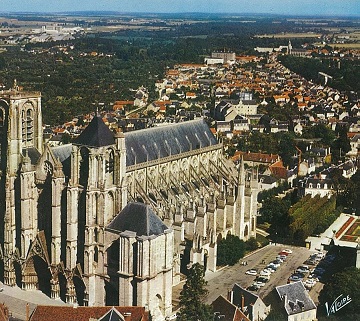
Jules was ordained in the Bourges Cathedral on the 14 June 1851. As a priest, Jules first served as curate in three different parishes in quick succession. Then at the age of thirty he was sent to Issoudun, which was regarded as the most dechristianised town in the whole region. The other curate in the parish was Fr Emile Maugenest, one of a small group of his companions in the seminary who had shared Chevalier's vision.
At Issoudun the two priests became determined to found a religious congregation of Missionaries of the Sacred Heart. However, aware that they could be deluding themselves they wanted a clear sign that this was what God wanted. Over a period of nine days, they prayed asking Our Lady to intercede for them in having God provide this sign. The following morning one of the parishioners called at the presbytery with a letter announcing a gift of 20,000 francs from an anonymous donor. The donor's preference was for a house of missionaries to be established in the area with the approval of the Archbishop. The Archbishop agreed as long as they had some means of financial independence and support. Another period of prayer resulted in another anonymous benefactor promising to give an annual gift of 1,000 francs which was enough for both of them to live on. They now had the sign and the means to begin the Missionaries of the Sacred Heart.
With the original 20,000 francs the two priests purchased a rundown vineyard with a sound house and tumbled-down barn in Issoudun. The house became their first community house and the barn was renovated as the first chapel, dedicated to the Sacred Heart of Jesus. This was in 1855. From these simple beginnings has come a whole family of Missionaries of the Sacred Heart - priests, brothers, sisters and lay associates.
The circumstances in France at the time were desperate for the ordinary person. They not only suffered in their family life and social interaction, they felt that religion was a thing of the past, and that the wars and revolutions meant that the world for them had changed. Jules set out to address this situation as he saw the Sacred Heart as the means of assisting the people to find God again. The humanity of Jesus and his relationship first to his Father and then with his mother Mary, held a special place for Jules. The statue of Our Lady of the Sacred Heart expressed for him this relationship, that if understood would help people find God again.
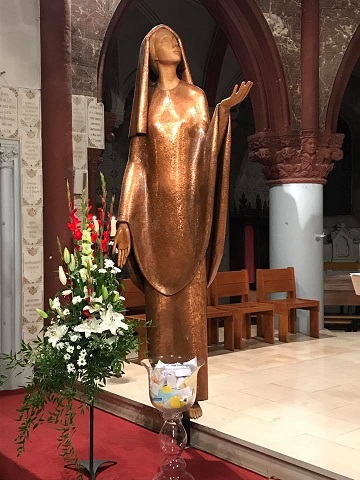
The French disillusion with God
After some difficult years of persecution in France and being forced to move to other parts of Europe, the new congregations began to grow and, at a very early stage, accepted responsibility for the Missions of Oceania.
It was as a direct result of this decision that the Missionaries of the Sacred Heart came to Australia at the end of the 19th century. Within twenty-five years of their small beginnings, the Missionaries of the Sacred Heart had spread in Europe and to North America. Before his death, Fr Jules Chevalier was to see his 'family' working in Central and South America, the Philippines, Australia and the Pacific Islands.
The sources of this paper were taken from notes and photos of Paul Cashen msc and texts from Jean Tostain msc “Father Chevalier”, the MSC website, from Wikipedia and map from Google.
Charism
Christopher Murphy, MSC:
Jules Chevalier from birth until his early years as an apostle to Issoudun.
For many years I used to regret that Jules Chevalier didn’t seem to do anything spectacularly holy in his early life. More lately I’ve heard and read that he regularly accompanied the local Parish Priest on his rounds after Mass each day (which he also attended). As a young lad of 11 or 12 this was a pretty heroic effort in a French winter I’d think.
When at 12 or so, he received his first Holy Communion, he surprisingly publicly stated (rare for him to reveal his deeper spiritual thoughts) that his 1st Holy Communion day was the happiest in his life, and furthermore, to the shock of his parents, he desired to become a priest.
Providence and a gift of money from a generous passer-by enabled Jules to start his Seminary days. The Seminary they recommended was just totally inappropriate for him, as it was a Minor Seminary and his fellow students at 13 or 14 were poor company.
Eventually it became clear that Jules needed to move on to the Seminary at Bourges Archdiocese, and here Jules performed admirably and with a number of fellow students he led and formed a small group of enthusiastic students into a group that they called the Knights of the Sacred Heart.
During his Seminary days he was very strong on his commitments to prayer and fidelity to all the spiritual exercises of the Seminary Day, but a little bit superior in his attitude to others who weren’t as easily to be highly committed as Jules.
Then a striking change came over Jules (on his Subdiaconate Retreat). For some providential reason, for the first time, Jules was dramatically led to a much deeper sense of compassion for others and his thinking and praying over many years, blossomed forth happily with the help of his Sacred Heart Devotion.
So when he was Ordained in the same year as his two best companions, Charles Piperon and Emile Maugenest, and when they found themselves all in the parish at Issoudun together, things looked good for the fledging group.
Unfortunately however their attempts to form the Sacred Heart Devotion failed to attract one person to their group. Not even one in a number of years.
That and other difficulties led him to seriously doubt his vision. It was just too hard (especially as Maugenest who was a strikingly gifted and popular person) was also called back to his own Diocese, and Jules felt his absence greatly.
It was so unlike Jules to be overcome by circumstances and a fellow priest recommended him to a visit with the famous Curé of Ars, who encouraged him to continue with his work with the Sacred Heart and he would do great things for all whom he met.
Spurred on by the Curé’s encouragement things in Issoudun improved and other joined him
- I haven’t mentioned the near death experience of Jules in the Seminary or drawn out its significance.
- Nor the details of the visit to the Curé, both of which were important.
Fr Chris Murphy, msc
22nd October, 2017
----------
Finally Bill Brady was called on to bring the meeting to a close.
